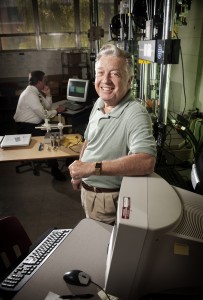One of Mississippi State University’s most distinguished engineering faculty members happens to be an alumnus of the University of Mississippi.
Jim Newman received his bachelor’s degree in civil engineering from Ole Miss in 1964. Since then, he’s evolved into one of the world’s leading fracture mechanics experts. Newman spent 37 years at NASA-Langley before coming to MSU in 2001.
“The education that I received at Ole Miss was the foundation for my future studies at Virginia Tech and my research work at the NASA Langley Research Center,” Newman said. “A job at NASA was a dream come true.”
Newman has received a legion of awards for his substantial contributions to fatigue and fracture mechanics, including the NASA Medal for Exceptional Scientific Achievement and the NASA Superstars in Aeronautics Award. He is a William Giles Professor at MSU (the highest honor a faculty member there can achieve) and he was the first recipient of the Richard Johnson Chair in Aerospace Engineering.
“At NASA and MSU, I have continued my research in the area of fatigue and fracture mechanics for aerospace materials and structures,” Newman said. “Since arriving at MSU, Dr. Steve Daniewicz, Dr. Judy Schneider and I have built a world-class fatigue and fracture laboratory, with the support of MSU’s Bagley College of Engineering and the Office of Research and Economic Development.”
Undoubtedly, Newman has earned the respect of his colleagues.
“Jim is an outstanding faculty member,” said Jason Keith, interim dean of MSU’s Bagley College of Engineering. “We are proud to have him in our college.”
“Jim is still very loyal to Ole Miss,” said Thomas E. Lacy Jr., professor and interim head of MSU’s Department of Aerospace Engineering. “When you meet Jim, I think you’ll find him to be a very genuine, kind, modest and down-to-earth person. That makes us feel especially lucky.”
A native of Memphis, Newman decided to attend UM because a cousin, Peggy Newman, and her husband, David Orr, attended Ole Miss a few years before him.
“I remember listening to the radio when Eagle Day was the Ole Miss quarterback,” he said. “As far back as I can remember, I was an Ole Miss football fan.”
One of Newman’s favorite engineering professors was C.C. Feng, who taught mechanics classes.
“I still have the notes that I took in his class and the homework assignments in my office at MSU,” Newman said. “I enjoyed his classes because he was tough and made us work a lot of homework. I believe in homework. That is the only way a student will ever learn the subject.”
Newman considers his selection as one of three engineers from Langley to be named Superstars in Modern Aeronautics (along with three engineers from several other NASA research centers) to be his greatest career achievement.
“I was placed on the same poster with Dr. Richard Whitcomb (Langley Research Center), the real superstar in aeronautics,” he said. “Dr. Whitcomb’s achievements were many times more significant than all of the others on the poster.”
Newman was married to Frances Mehan Newman, who passed away in January 2014. They had four sons.
“My mother, my sons and my grandkids are the greatest joy in my life,” Newman said. “My dad was my inspiration to become an engineer, but he passed away in January 1980. Ironically, after World War II, he was a ‘crack’ inspector for an airline in Memphis. And his son would become a world expert on ‘crack’ mechanics (the field of fracture mechanics).”
